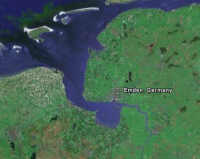
 |
||
| Home - People - Participants - Research - Publications - Contact Us |

|
Dynamics of Estuarine Turbidity Maxima (ETM):coupling of morphology and biology
LOICZ project 014.27.013 Dr. Stefan Talke - Prof. Dr. Victor de Jonge - Prof. Dr. Huib de Swart Research Over the past year we have made much progress in researching the turbidity maximum of the Ems Estuary. We have planned and executed numerous field campaigns over the year to measure various biological and physical parameters. Field Campaigns occurred in each month from February to October 2005, and required coordinating the efforts of various Dutch and German agencies and companies, including WSA Emden, Niedersachsen Ports GmBH, Rijkswaterstaat, NIOZ, Bundesanstalt für Gewässerkunde (BfG), Bundesanstalt für Wasserbau (BAW-Hamburg), and Aquavision.
Figure 1: Sediment Concentration at a cross-section of the Ems River near Pogum in March, 2005 during the flood tide. Blank areas refer to sediment concentrations greater than 5 g/L. Note that fluid mud is beginning to pool in the bottom of the main channel, as evidenced by the deviation of the 210 kHz echosounder (magenta line) from the 15 kHz echosounder (blue line).
Using the ships of NP, RWS, and WSA Emden, we measured both along the main axis of the river and estuary and along selected cross-sections. Measurements include physical variables such as velocity (ADCP), sediment concentration (ADCP and OBS), salinity, and temperature and biological measurements such as fluorescence (for algae concentrations), nutrients (e.g. phosphorous, silicates, and nitrogen), and oxygen concentration. Experiments have resumed in February 2006. Our analysis of field data shows that sediment concentrations at the turbidity maximum are large enough to significantly affect the density, mixing and flow patterns of water in the vertical and longitudinal directions. Moreover, the distribution of sediment concentration along the main axis of the estuary is not symmetrical around the turbidity maximum (see figure 2). The tidally-averaged circulation patterns set up by the tides, the freshwater-saltwater density differences, and the longitudinal gradients in turbidity also affect the distribution of biological parameters such as algae and oxygen concentration (figure 2). Our results have led us to begin designing an analytical model that can look specifically at the affect of high sediment concentration on the flow patterns of the river and estuary.
Figure 2: Distribution of Turbidity, Salinity, oxygen, and Fluorescence in surface water along a longitudinal transect of the Ems River on September 28, 2005. Note the asymmetric profile of turbidity and the low oxygen concentrations.
In 2006 we plan to continue our experiments, using the knowledge we have learned in the last year to refine our techniques. During this year we will focus more on fixed measurements and cross-sectional measurements to gain better knowledge of how sediment concentrations vary over a tide and what physical forces play a role. Moreover, we will specifically try to measure the currents that are being formed by the turbidity, and look at how biological parameters are mixed through the water column and over the length of the river. We are currently developing an analytic model to explain the asymmetric distribution of sediment concentration along the longitudinal axis of the Ems Estuary. This analytical model will help us understand the circulation patterns around the turbidity maximum and how they are affected by river flow and tides. Moreover, we will also investigate the mixing of sediment and biological parameters through the water column using a state-of-the-art turbulence modelling program (General Ocean Turbulence Model, GOTM). We will continue our analysis of the data we collect and get better estimates of sediment concentration, velocity, turbulence in the water, and biological parameters. We will also investigate seasonal influences on both the physical and biological measurements. For more detailed information, feel free to download a copy of the poster presented at the ERF Conference in Virginia in October, 2005: Download ERF Poster An updated synopsis of our work was presented at a workshop in Groningen on March 3, 2006: Download Groningen Presentation
The ETM group is part of the coastal group of the physical oceanography section fo the Institute for Marine and Atmospheric Studies, Utrecht (IMAU). The IMAU is part of the Department of Physics and Astronomy at the University of Utrecht, Netherlands.
This project is financed by the Netherlands Organization for Scientific Research (NWO, see http://www.nwo.nl/), section Earth & Life Sciences (ALW), as part of the program 'Land-Ocean Interaction in the Coastal Zone' (LOICZ).
last modified: 10-03-2006 16:00 |
|
||||||